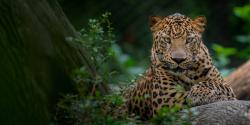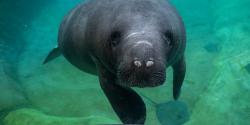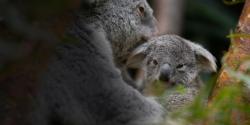Any true crime fan has probably heard the trope of a parrot giving away the murderer with its keen ability to mimic human voices; however, the real crime related to parrots is the illegal pet trade.
One species that is known for its clear mimicking ability is the African grey parrot (Psittacus erithacus). These parrots have been household pets since 2000 BC(1) and have continued to grow in popularity to this day due to their incredible intelligence.(2) African grey parrots are the second most-trafficked parrot in the world, with some studies estimating that up to 20 percent of the African grey parrot wild population is collected annually.(3)(4)

Here at the Columbus Zoo and Aquarium, we care for a flock of eight African grey parrots. If you have visited our Congo Basecamp Aviary, I am sure one “wolf whistled” or said “hi” as you stopped to check them out. You might also catch a glimpse of one of the Animal Care team members training and interacting with the birds, but these interactions are not just keeper and bird play time. Keeper Moe Duffy shares, “We work with the parrots to train them on different behaviors that allow us to keep track of their health and wellbeing. Things like nail trims, scale training, or even head scratches make it so that we can create a stronger relationship to keep our birds in good physical and mental condition.” Seeing these types of interactions can be endearing and why so many people want to own these birds at home. However, pet parrot ownership can be problematic, not just for their wild populations, but for the owners and parrots themselves.
The average parrot will go through 7-10 homes during its lifetime in human care, and there are currently over 200,000 parrots in rescues in the United States that are looking for their forever home.
Although charismatic and charming, these clever birds can be tough to share space with.
- They are incredibly messy! They will chew up anything and everything they can get their beaks on (which, by the way, are super strong and sharp nutcrackers...so you don’t want to get bitten by one).
- They are loud and will often “contact call” in the morning and afternoon.
- They require tons of attention and are highly social.
- They live a long time, with some living into their 50s-60s.
Sometimes described as “having a 3-year-old in your house for 60+ years," parrots may not the best choice for the average pet owner. However, at the Zoo, where we have an experienced team to care for them daily, we love having parrots so we can share their amazing natural behaviors with our guests.
The Columbus Zoo and Aquarium is doing its part for African grey parrots.
- We’re members of the AZA Wildlife Trafficking Alliance (WTA) to help ensure conservation of this species. WTA seeks to “Raise the public’s awareness of the scope of the wildlife trafficking crisis; Effect behavior change in order to reduce consumer demand for wildlife and wildlife products; and Mobilize companies to adopt best practices to assure that their goods and services are not being utilized by illegal wildlife traffickers, and to assist in raising public awareness and reducing demand.” (5)
- Representatives from the Zoo regularly attend the Convention on International Trade in Endangered Species of Wild Fauna and Flora (CITES) conferences, where the parrot trade is discussed as an international crisis. African grey parrots are listed in CITES Appendix I, the highest level of protection under the Treaty, due to their threat of extinction. The international trade of this species is generally prohibited except under certain conditions. There is a complete ban on imports of any African grey parrots originating from the Democratic Republic of Congo. However, the Zoo doesn’t stop there; we take strides to educate our guests on responsible parrot acquisition and the difficulties of having a parrot in the home.

So how can you help African Grey parrot populations? Dr. Mike Kreger, Vice President of Conservation at the Columbus Zoo and Aquarium, says one of the best ways to help parrot conservation is to, “Know the source of the bird you are buying. Know the origin. The sale of wild-caught birds often puts pressure on wild populations to supply the market.”
But, if you must have a parrot, here are some tips:
- A great place to start is your local parrot rescue.
- Consider fostering a parrot first to make sure it is the right fit for your whole family.
- If you do decide to adopt, harness the power of social media and use the hashtag #rescueparrot on pics you have of your new feathered friend.
- Lastly, don't forget to do research on parrot ownership, including where the parrots are being sourced from, etc.
By supporting the Columbus Zoo, you are supporting our conservation efforts that help animals, including these incredible parrots, worldwide. Stop by the Congo Basecamp Aviary to see and hear our boisterous flock of African grey parrots and meet some of their larger macaw cousins at Jack Hanna's Animal Encounters Village in our Adventure Cove region.
Learn More About African Grey Parrots
(1) U.S. pet ownership statistics. American Veterinary Medical Association. (n.d.). https://www.avma.org/resources-tools/reports-statistics/us-pet-ownership-statistics
(2) Davies, A., Hinsley, A., Nuno, A., & Martin, R. O. (2022). Identifying opportunities for expert‐mediated triangulation in monitoring wildlife trade on social media. Conservation Biology. https://doi.org/10.1111/cobi.13858
(3) Holman, Rachel. “Psittacus Erithacus (GREY Parrot).” Animal Diversity Web, University of Michigan Museum of Zoology, Apr. 2008, animaldiversity.org/accounts/Psittacus_erithacus/.
(4) BirdLife International. 2018. Psittacus erithacus. The IUCN Red List of Threatened Species 2018: e.T22724813A129879439. https://dx.doi.org/10.2305/IUCN.UK.2018- 2 .RLTS.T22724813A129879439.en. Downloaded on 31 July 2021









